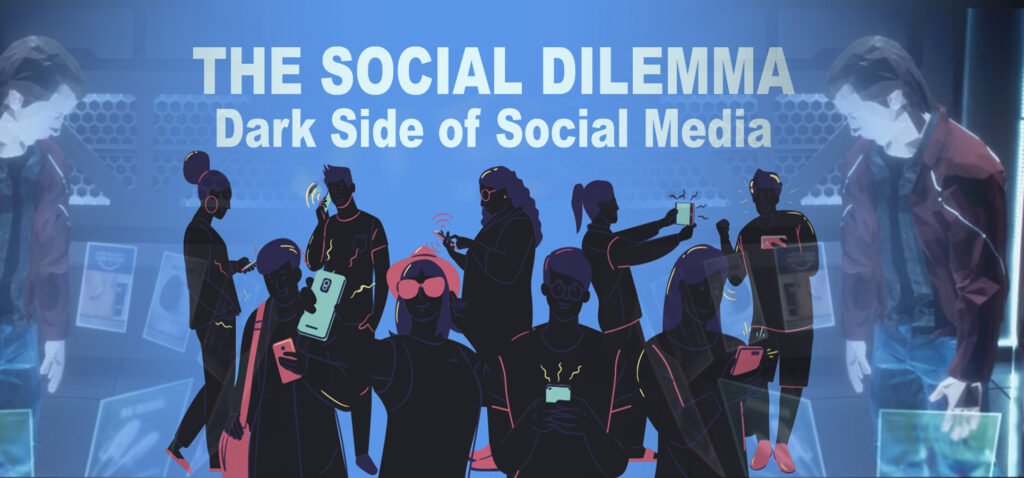Introduction: Unmasking the Algorithmic Influence
In today’s hyper-connected world, social media algorithms control what billions of users see every day, shaping opinions, driving behaviors, and influencing decisions in ways many do not consciously realize. These algorithms are designed to maximize engagement, keep users scrolling, and ultimately increase advertising revenue. While they provide a personalized experience that feels convenient and relevant, the darker consequences often remain hidden. From amplifying misinformation to creating echo chambers, and from eroding mental health to manipulating consumer habits, the impact of algorithm-driven feeds goes far beyond entertainment. Understanding the dark side of social media algorithms is crucial for individuals, businesses, and policymakers who are navigating a world where digital platforms wield immense, often unchecked, power.
How Social Media Algorithms Work
Algorithms are essentially sets of rules and machine learning models that determine which posts, videos, or advertisements appear on your feed. Platforms like Facebook, TikTok, Instagram, YouTube, and X (formerly Twitter) rely on these systems to prioritize content based on relevance, engagement potential, and predicted user behavior. The more a user engages with certain types of content, the more similar material they are shown. While this creates an illusion of personalization, it also leads to an invisible curation of reality, limiting exposure to diverse viewpoints. The constant fine-tuning of these algorithms ensures users spend more time on the platform, but it also gives companies an unprecedented ability to influence public opinion and personal choices.
The Hidden Costs of Algorithmic Personalization
Personalization feels beneficial on the surface, but it comes with trade-offs that many users fail to notice. Platforms collect vast amounts of data to feed their algorithms: browsing history, likes, comments, shares, time spent on posts, and even off-platform activity. This behavioral surveillance not only erodes privacy but also traps users in cycles of highly targeted content. Instead of broadening horizons, algorithms reinforce pre-existing beliefs and interests, creating filter bubbles.
- Algorithms prioritize emotional content over factual content.
- Personalized feeds reduce exposure to diverse perspectives.
- Data-driven targeting raises ethical concerns over privacy.
- Engagement-based ranking fuels polarizing conversations.
- Long-term reliance weakens independent critical thinking.
This cycle leads to homogenized thinking, where individuals see only what algorithms deem relevant, reducing opportunities for genuine discovery or balanced dialogue.
The Mental Health Implications of Algorithmic Feeds
The dark side of social media algorithms becomes starkly visible when looking at mental health outcomes. Studies consistently show a correlation between algorithm-driven platforms and increased anxiety, depression, and low self-esteem, especially among younger users. Algorithms are optimized to exploit human psychology, rewarding users with dopamine hits from likes and shares. The endless scroll, fueled by “variable rewards,” keeps individuals engaged at the cost of sleep, focus, and overall well-being.
For teenagers, algorithms can be particularly damaging. Exposure to idealized body images, popularity metrics, or polarizing political content fosters unhealthy comparisons and heightened stress. Instead of offering a balanced digital diet, algorithms feed users the very content most likely to keep them hooked, regardless of its psychological toll.
Echo Chambers and the Spread of Misinformation
A central criticism of algorithm-driven feeds is their role in amplifying echo chambers—closed networks where users are surrounded by like-minded views. When people repeatedly encounter the same ideas without contradiction, their beliefs harden, and opposing perspectives are dismissed. This insular environment makes it easier for misinformation and conspiracy theories to spread unchecked.
Consider platforms like Facebook and YouTube during election cycles or global health crises. Content that triggers outrage or emotional responses is more likely to be shared, even if it’s misleading. Algorithms, tuned to maximize clicks and watch time, inadvertently elevate false narratives while burying factual reporting. This not only undermines public trust in institutions but also destabilizes democratic processes.
Comparison Table: Positive vs. Negative Impacts of Algorithms
| Aspect | Positive Impact | Negative Impact |
| Personalization | Relevant content tailored to user interests | Reinforces bias, limits exposure to new perspectives |
| Engagement | Higher user activity and retention | Addiction, reduced productivity |
| Advertising | More effective targeting for businesses | Intrusive data collection, privacy erosion |
| Content Discovery | Easier access to trending material | Amplifies misinformation and harmful trends |
| Mental Health | Community building and belonging | Anxiety, depression, comparison culture |
The Commercial Manipulation of Consumer Behavior
The business model behind social media algorithms relies heavily on advertising. Every scroll, click, and pause is tracked to create detailed profiles that predict consumer behavior. This surveillance capitalism allows brands to micro-target audiences with uncanny precision. For instance, someone researching fitness may suddenly find their feed filled with ads for supplements, gym memberships, or workout apps. While this seems convenient, it manipulates purchasing decisions by exploiting vulnerabilities.
Moreover, the line between organic content and advertising is increasingly blurred. Influencers and sponsored posts often appear seamlessly alongside user-generated content, making it difficult to distinguish authentic recommendations from paid promotions. The algorithm ensures maximum visibility for profitable content, further prioritizing commercial gain over user well-being.
Political Influence and Algorithmic Bias
One of the most concerning aspects of algorithmic design is its potential to sway political opinions. Platforms have been criticized for harboring biases, whether through unintentional coding choices or deliberate corporate interests. During elections, algorithm-driven feeds can amplify divisive rhetoric, suppress minority voices, or spread misinformation campaigns.
For example, studies have shown that political advertising on platforms like Facebook can be micro-targeted to specific demographics, tailoring messages that play to fears, prejudices, or aspirations. This level of precision raises ethical questions about fairness, transparency, and manipulation in democratic processes. The problem is compounded when algorithms, optimized for engagement, favor polarizing or emotionally charged content that exacerbates division.
Case Study Table: Algorithm-Driven Controversies
| Platform | Controversy | Algorithmic Role |
| Cambridge Analytica scandal | Data misuse for political micro-targeting | |
| YouTube | Radicalization pipeline | Recommendation engine promoting extreme content |
| TikTok | Harmful trends and challenges | Amplification of viral but dangerous behaviors |
| Teen mental health crisis | Algorithm surfacing idealized body images | |
| Twitter/X | Election misinformation campaigns | Engagement-driven amplification of false claims |
Regulation and Ethical Challenges
Governments worldwide are beginning to recognize the dangers of unregulated social media algorithms. Discussions about transparency, accountability, and ethical design are gaining momentum. The European Union’s Digital Services Act (DSA), for example, requires platforms to disclose how their algorithms work and provide users with more control over their feeds. Similarly, debates in the United States focus on regulating data privacy, harmful content, and algorithmic bias.
However, regulating algorithms is complex. Overregulation could stifle innovation, while under-regulation leaves users vulnerable to exploitation. Striking the right balance requires collaboration between policymakers, technologists, and civil society groups. Ethical challenges also extend to AI biases, as algorithms trained on flawed or biased data may unintentionally perpetuate discrimination or inequality.
Practical Steps for Users to Take Control
While systemic change requires regulation and corporate responsibility, individuals can take proactive measures to reduce the negative impact of algorithms on their lives. Some strategies include adjusting privacy settings, limiting screen time, and diversifying information sources. Using alternative feeds, such as chronological timelines, can also reduce algorithmic influence.
- Regularly review and update privacy settings.
- Follow diverse accounts to avoid echo chambers.
- Use tools or browser extensions that block tracking.
- Set daily screen-time limits for healthier balance.
- Fact-check content before sharing or engaging.
These small but consistent actions can help reclaim agency in an environment designed to prioritize corporate interests over user well-being.
Conclusion: Toward a More Ethical Digital Future
The dark side of social media algorithms reveals a pressing need for greater awareness, accountability, and reform. While algorithms have made digital platforms more engaging and profitable, their hidden costs—from mental health challenges to democratic threats—cannot be ignored. Addressing these issues requires a combined effort: governments must regulate responsibly, companies must prioritize ethical design, and users must cultivate digital literacy. By acknowledging both the benefits and dangers of algorithm-driven platforms, society can work toward a healthier digital ecosystem where personalization enhances rather than exploits human potential.
FAQs About the Dark Side of Social Media Algorithms
1. What are social media algorithms?
They are systems that decide what content appears on your feed based on engagement history, behavior, and interests.
2. Why are social media algorithms dangerous?
They can amplify misinformation, create echo chambers, damage mental health, and manipulate consumer behavior.
3. How do algorithms affect mental health?
By promoting addictive scrolling and fostering unhealthy comparisons, they increase risks of anxiety, depression, and poor self-esteem.
4. Do social media platforms profit from algorithms?
Yes, they use algorithms to maximize engagement and advertising revenue, often prioritizing profit over user well-being.
5. Can algorithms spread misinformation?
Absolutely. Content that generates outrage or emotion is often boosted, regardless of accuracy.
6. What is an echo chamber in social media?
It’s a closed digital environment where users only see content that aligns with their existing beliefs, limiting exposure to diverse perspectives.
7. Are social media algorithms biased?
Yes, biases can occur due to flawed data, intentional design, or optimization for polarizing content.
8. How can I reduce algorithm influence?
You can diversify your sources, use chronological feeds, adjust privacy settings, and fact-check content.
9. Are governments regulating social media algorithms?
Yes, regions like the EU have introduced laws like the Digital Services Act to increase transparency and accountability.
10. Can we design ethical algorithms?
Yes, with transparency, fairness, and user well-being as priorities, ethical algorithms can be developed to balance personalization and responsibility.


